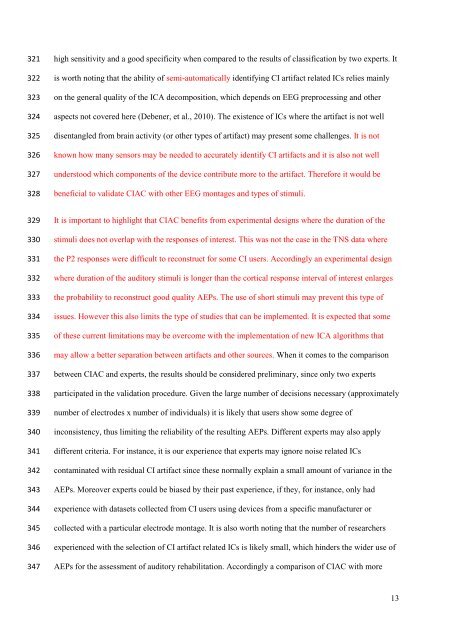Elsevier Editorial System(tm) for Hearing Research Manuscript Draft ...
Elsevier Editorial System(tm) for Hearing Research Manuscript Draft ...
Elsevier Editorial System(tm) for Hearing Research Manuscript Draft ...
You also want an ePaper? Increase the reach of your titles
YUMPU automatically turns print PDFs into web optimized ePapers that Google loves.
321<br />
322<br />
323<br />
324<br />
325<br />
326<br />
327<br />
328<br />
329<br />
330<br />
331<br />
332<br />
333<br />
334<br />
335<br />
336<br />
337<br />
338<br />
339<br />
340<br />
341<br />
342<br />
343<br />
344<br />
345<br />
346<br />
347<br />
high sensitivity and a good specificity when compared to the results of classification by two experts. It<br />
is worth noting that the ability of semi-automatically identifying CI artifact related ICs relies mainly<br />
on the general quality of the ICA decomposition, which depends on EEG preprocessing and other<br />
aspects not covered here (Debener, et al., 2010). The existence of ICs where the artifact is not well<br />
disentangled from brain activity (or other types of artifact) may present some challenges. It is not<br />
known how many sensors may be needed to accurately identify CI artifacts and it is also not well<br />
understood which components of the device contribute more to the artifact. There<strong>for</strong>e it would be<br />
beneficial to validate CIAC with other EEG montages and types of stimuli.<br />
It is important to highlight that CIAC benefits from experimental designs where the duration of the<br />
stimuli does not overlap with the responses of interest. This was not the case in the TNS data where<br />
the P2 responses were difficult to reconstruct <strong>for</strong> some CI users. Accordingly an experimental design<br />
where duration of the auditory stimuli is longer than the cortical response interval of interest enlarges<br />
the probability to reconstruct good quality AEPs. The use of short stimuli may prevent this type of<br />
issues. However this also limits the type of studies that can be implemented. It is expected that some<br />
of these current limitations may be overcome with the implementation of new ICA algorithms that<br />
may allow a better separation between artifacts and other sources. When it comes to the comparison<br />
between CIAC and experts, the results should be considered preliminary, since only two experts<br />
participated in the validation procedure. Given the large number of decisions necessary (approximately<br />
number of electrodes x number of individuals) it is likely that users show some degree of<br />
inconsistency, thus limiting the reliability of the resulting AEPs. Different experts may also apply<br />
different criteria. For instance, it is our experience that experts may ignore noise related ICs<br />
contaminated with residual CI artifact since these normally explain a small amount of variance in the<br />
AEPs. Moreover experts could be biased by their past experience, if they, <strong>for</strong> instance, only had<br />
experience with datasets collected from CI users using devices from a specific manufacturer or<br />
collected with a particular electrode montage. It is also worth noting that the number of researchers<br />
experienced with the selection of CI artifact related ICs is likely small, which hinders the wider use of<br />
AEPs <strong>for</strong> the assessment of auditory rehabilitation. Accordingly a comparison of CIAC with more<br />
13
















